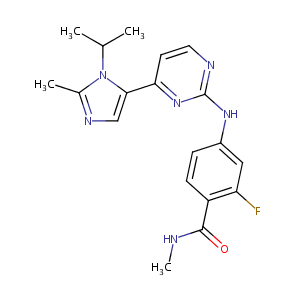| Drug General Information |
| Drug ID |
D0P6JS
|
| Former ID |
DIB019624
|
| Drug Name |
compound 9b
|
| Drug Type |
Small molecular drug
|
| Indication |
Discovery agent
|
Investigative |
[1]
|
|---|
| Structure |

|
Download
2D MOL
|
| Formula |
C19H21FN6O
|
| InChI |
InChI=1S/C19H21FN6O/c1-11(2)26-12(3)23-10-17(26)16-7-8-22-19(25-16)24-13-5-6-14(15(20)9-13)18(27)21-4/h5-11H,1-4H3,(H,21,27)(H,22,24,25)
|
| InChIKey |
OCUYCOQPRGFQEV-UHFFFAOYSA-N
|
| PubChem Compound ID |
|
| PubChem Substance ID |
|
| Target and Pathway |
| Target(s) |
Cell division protein kinase 2 |
Target Info |
Inhibitor |
[1]
|
|---|
| cyclin-dependent kinase-like 1 (CDC2-related kinase) |
Target Info |
Inhibitor |
[1]
|
| Cell division control protein 2 homolog |
Target Info |
Inhibitor |
[1]
|
| Cell division protein kinase 4 |
Target Info |
Inhibitor |
[1]
|
|
KEGG Pathway
|
FoxO signaling pathway
|
|
Cell cycle
|
|
Oocyte meiosis
|
|
p53 signaling pathway
|
|
PI3K-Akt signaling pathway
|
|
Progesterone-mediated oocyte maturation
|
|
Hepatitis B
|
|
Measles
|
|
Herpes simplex infection
|
|
Epstein-Barr virus infection
|
|
Pathways in cancer
|
|
Viral carcinogenesis
|
|
Prostate cancer
|
|
Small cell lung cancerhsa04110:Cell cycle
|
|
Gap junction
|
|
Viral carcinogenesishsa04110:Cell cycle
|
|
Tight junction
|
|
T cell receptor signaling pathway
|
|
HTLV-I infection
|
|
Pancreatic cancer
|
|
Glioma
|
|
Melanoma
|
|
Bladder cancer
|
|
Chronic myeloid leukemia
|
|
Small cell lung cancer
|
|
Non-small cell lung cancer
|
|
NetPath Pathway
|
TCR Signaling PathwayNetPath_21:RANKL Signaling PathwayNetPath_11:TCR Signaling Pathway
|
|
EGFR1 Signaling Pathway
|
|
RANKL Signaling Pathway
|
|
PANTHER Pathway
|
p53 pathway
|
|
p53 pathway feedback loops 2
|
|
Pathway Interaction Database
|
Regulation of nuclear SMAD2/3 signaling
|
|
Signaling events mediated by PRL
|
|
p73 transcription factor network
|
|
E2F transcription factor network
|
|
ATR signaling pathway
|
|
mTOR signaling pathway
|
|
IL2-mediated signaling events
|
|
FoxO family signaling
|
|
FOXM1 transcription factor network
|
|
BARD1 signaling events
|
|
p53 pathway
|
|
Regulation of retinoblastoma proteinp73pathway:p73 transcription factor network
|
|
PLK1 signaling events
|
|
AP-1 transcription factor network
|
|
Retinoic acid receptors-mediated signalingsmad2_3nuclearpathway:Regulation of nuclear SMAD2/3 signaling
|
|
Calcineurin-regulated NFAT-dependent transcription in lymphocytes
|
|
Validated targets of C-MYC transcriptional activation
|
|
ATF-2 transcription factor network
|
|
Regulation of retinoblastoma protein
|
|
Reactome
|
G0 and Early G1
|
|
Activation of ATR in response to replication stress
|
|
Regulation of APC/C activators between G1/S and early anaphase
|
|
SCF(Skp2)-mediated degradation of p27/p21
|
|
Senescence-Associated Secretory Phenotype (SASP)
|
|
DNA Damage/Telomere Stress Induced Senescence
|
|
Processing of DNA double-strand break ends
|
|
G2 Phase
|
|
Orc1 removal from chromatin
|
|
Cyclin E associated events during G1/S transition
|
|
Cyclin A/B1 associated events during G2/M transition
|
|
p53-Dependent G1 DNA Damage Response
|
|
Cyclin A:Cdk2-associated events at S phase entry
|
|
Meiotic recombination
|
|
Factors involved in megakaryocyte development and platelet productionR-HSA-110056:MAPK3 (ERK1) activation
|
|
E2F mediated regulation of DNA replication
|
|
Cyclin B2 mediated events
|
|
Golgi Cisternae Pericentriolar Stack Reorganization
|
|
Cdc20:Phospho-APC/C mediated degradation of Cyclin A
|
|
Phosphorylation of the APC/C
|
|
Phosphorylation of Emi1
|
|
Condensation of Prophase Chromosomes
|
|
MASTL Facilitates Mitotic Progression
|
|
Resolution of Sister Chromatid Cohesion
|
|
Condensation of Prometaphase Chromosomes
|
|
Regulation of PLK1 Activity at G2/M Transition
|
|
Activation of NIMA Kinases NEK9, NEK6, NEK7
|
|
Loss of Nlp from mitotic centrosomes
|
|
Recruitment of mitotic centrosome proteins and complexes
|
|
Loss of proteins required for interphase microtubule organization?from the centrosome
|
|
Recruitment of NuMA to mitotic centrosomes
|
|
Depolymerisation of the Nuclear Lamina
|
|
Anchoring of the basal body to the plasma membrane
|
|
MAPK6/MAPK4 signaling
|
|
G1/S-Specific Transcription
|
|
G2/M DNA replication checkpoint
|
|
Chk1/Chk2(Cds1) mediated inactivation of Cyclin B:Cdk1 complexR-HSA-2559580:Oxidative Stress Induced Senescence
|
|
Oncogene Induced Senescence
|
|
RMTs methylate histone arginines
|
|
Transcriptional regulation of white adipocyte differentiation
|
|
Ubiquitin-dependent degradation of Cyclin D1
|
|
Cyclin D associated events in G1
|
|
WikiPathways
|
DNA Damage Response
|
|
ID signaling pathway
|
|
DNA Replication
|
|
G1 to S cell cycle control
|
|
M/G1 Transition
|
|
S Phase
|
|
Meiotic Recombination
|
|
Aryl Hydrocarbon Receptor
|
|
ATM Signaling Pathway
|
|
Retinoblastoma (RB) in Cancer
|
|
Spinal Cord Injury
|
|
Integrated Pancreatic Cancer Pathway
|
|
Oncostatin M Signaling Pathway
|
|
Prostate Cancer
|
|
Signaling Pathways in Glioblastoma
|
|
TSH signaling pathway
|
|
Integrated Breast Cancer Pathway
|
|
Integrated Cancer pathway
|
|
Synthesis of DNA
|
|
Regulation of DNA replication
|
|
Mitotic G2-G2/M phases
|
|
Mitotic G1-G1/S phases
|
|
Factors involved in megakaryocyte development and platelet production
|
|
Cell Cycle
|
|
APC/C-mediated degradation of cell cycle proteins
|
|
Cell Cycle Checkpoints
|
|
miRNA Regulation of DNA Damage ResponseWP707:DNA Damage Response
|
|
TGF beta Signaling Pathway
|
|
PPAR Alpha Pathway
|
|
MAP kinase activation in TLR cascade
|
|
RAF/MAP kinase cascade
|
|
Mitotic Prophase
|
|
Mitotic Prometaphase
|
|
BMI1
|
|
Regulation of Microtubule Cytoskeleton
|
|
Ovarian Infertility Genes
|
|
Bladder Cancer
|
|
Transcriptional Regulation of White Adipocyte Differentiation
|
|
miRNA Regulation of DNA Damage Response
|
| References |
| REF 1 | Bioorg Med Chem Lett. 2008 Dec 15;18(24):6486-9. Epub 2008 Oct 22.Imidazole pyrimidine amides as potent, orally bioavailable cyclin-dependent kinase inhibitors. |
|---|